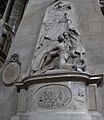John Bacon (sculptor, born 1777) facts for kids
John Bacon (1777–1859), also known as John Bacon the Younger, was a famous English sculptor. He was called "the Younger" to tell him apart from his equally well-known father, who was also a sculptor.
A Young Sculptor's Life

John Bacon the Younger was born in London on March 13, 1777. His father, John Bacon, was also a sculptor. John was a very talented artist from a young age. He joined the Royal Academy Schools when he was only twelve years old, making him one of the youngest students ever!
He showed his first artwork at fifteen. At sixteen, he won a silver medal from the Royal Academy. In 1797, he won a gold medal for his statue of Cassandra. When his father passed away in 1799, young John took over the family business. He finished many projects his father had started, like the famous statue of Lord Cornwallis. John Bacon the Younger became very successful and continued to create many sculptures. He stopped showing his work at the Royal Academy in 1824.
John Bacon also worked on big building projects. In 1796, he created the figure of "Providence" for Trinity House. In 1814, he replaced the figures of "Madness" and "Melancholy" at the entrance of Bethlem Hospital, which was also known as Bedlam.
You can find six of Bacon's sculptures in St Paul's Cathedral and at least eight in Westminster Abbey. There are also two of his works in Windsor Castle.
From 1818 to 1843, Bacon worked with a former student named Samuel Manning. However, it seems that most of the work during this time was done by Manning, even though it used Bacon's good name. John Bacon himself mostly retired from sculpting around 1830. He also wrote articles about sculpture for a large encyclopedia called Rees's Cyclopædia.
In 1801, he married Susanna Sophia Taylor. John Bacon the Younger passed away in Bath, Somerset on July 14, 1859.
Famous Sculptures and Monuments
John Bacon the Younger created many important sculptures and monuments. Here are some of his notable works:
- A bust (a sculpture of someone's head and shoulders) of Bishop John Thomas at Westminster Abbey (1793).
- A sculpture group for Captain Edward Cooke RN at Westminster Abbey (1799).
- A monument for Sir John Meredith at Brecon Cathedral (1800).
- The statue of Charles Cornwallis, 1st Marquess Cornwallis at the Victoria Memorial, Kolkata (1803). There's also a copy of this statue in Bombay.
- A sculpture group for Captains John Harvey RN and John Hutt RN at Westminster Abbey (1804).
- A bust and sculpture group for General Thomas Dundas at St Paul's Cathedral (1805).
- The famous equestrian statue of King William III in St James's Square, London (1808). An equestrian statue shows a person riding a horse.
- A sculpture group for Sir John Moore at St Paul's Cathedral (1809).
- A sculpture group for Charles Agar, 1st Earl of Normanton at Westminster Abbey (1815).
- A bust and plaque for Warren Hastings at Westminster Abbey (1818). This work was designed by Bacon, with the bust made by Samuel Manning.
Other Works
Bacon also created many other sculptures, including:
- Moses Striking the Rock (1792)
- A bust of his father, John Bacon RA (1798)
- The tomb of Dr William Heberden (1801) in Windsor Parish Church
- A monument to Lord Rokeby at Armagh Cathedral (1802)
- A bust of William Markham, Archbishop of York (1804) in Christ Church, Oxford
- Monuments with carved military symbols for John Yorke and Martin Yorke in the Church of St Mary the Virgin, Speldhurst Hill, Kent
- A memorial, which is a deep relief plaque, for Captain George Bryan at Westminster Abbey (1809)
- Statues of Marquess Wellesley in Calcutta and Mumbai (1809)
- A monument for General Crawfurd and General Henry MacKinnon at St Paul's Cathedral (1812)
- A statue of George III at the Bank of Ireland (1813)
- A monument for Sir Thomas Trigge at Westminster Abbey (1814)
- The Flight of Aeneas from Troy, a panel over a doorway at the Foundling Museum, London (1839)
- His daughter's tomb in St Thomas Church in Exeter (1842)
Images for kids























